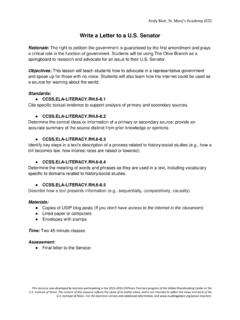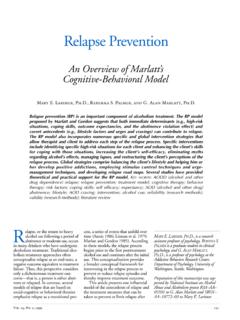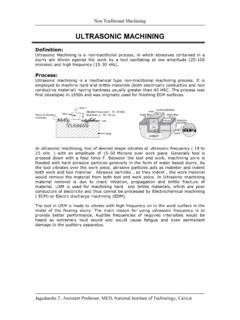Transcription of UNITED STATES INSTITUTE OF PEACE SPECIAL REPORT
1 Gabriel WeimannCyberterrorismHow Real Is the Threat?Summary The potential threat posed by cyberterrorism has provoked considerable alarm. Numer-ous security experts, politicians, and others have publicized the danger of cyberterror-ists hacking into government and private computer systems and crippling the military, financial, and service sectors of advanced economies. The potential threat is, indeed, very alarming. And yet, despite all the gloomy pre-dictions, no single instance of real cyberterrorism has been recorded.
2 This raises the question: just how real is the threat? Psychological, political, and economic forces have combined to promote the fear of cyberterrorism. From a psychological perspective, two of the greatest fears of modern time are combined in the term cyberterrorism. The fear of random, violent victimiza-tion blends well with the distrust and outright fear of computer technology. Even before 9/11, a number of exercises identified apparent vulnerabilities in the com-puter networks of the military and energy sectors.
3 After 9/11, the security and terrorism discourse soon featured cyberterrorism prominently, promoted by interested actors from the political, business, and security circles. Cyberterrorism is, to be sure, an attractive option for modern terrorists, who value its anonymity, its potential to inflict massive damage, its psychological impact, and its media appeal. Cyberfears have, however, been exaggerated. Cyberattacks on critical components of the national infrastructure are not uncommon, but they have not been conducted by terrorists and have not sought to inflict the kind of damage that would qualify as cyberterrorism.
4 Nuclear weapons and other sensitive military systems, as well as the computer systems of the CIA and FBI, are air-gapped, making them inaccessible to outside hackers. Systems in the private sector tend to be less well protected, but they are far from defenseless, and nightmarish tales of their vulnerability tend to be largely 17th Street NW Washington, DC 20036 fax REPORT 119 December 2004 ABOUT THE REPORT The threat posed by cyberterrorism has grabbed headlines and the attention of politicians, security experts, and the public.
5 But just how real is the threat? Could terrorists cripple critical military, financial, and service computer systems? This REPORT charts the rise of cyberangst and examines the evidence cited by those who predict imminent catastrophe. Many of these fears, the REPORT contends, are exaggerated: not a single case of cyberterrorism has yet been recorded, hackers are regularly mistaken for terrorists, and cyberdefenses are more robust than is commonly supposed. Even so, the potential threat is undeniable and seems likely to increase, making it all the more important to address the danger without inflating or manipulating Weimann is a senior fellow at the UNITED STATES INSTITUTE of PEACE and professor of communication at the University of Haifa, Israel.
6 He has written widely on modern terrorism, political campaigns, and the mass media. This REPORT complements a previous REPORT , , issued in March 2004, which examined the variety of uses to which terrorists routinely put the Internet. Both reports distill some of the findings from an ongoing, six-year study of terrorism and the Internet. A book based on that larger study is to be published in views expressed in this REPORT do not necessarily reflect views of the UNITED STATES INSTITUTE of PEACE , which does not advocate specific policy STATES INSTITUTE OF PEACECONTENTS Introduction 2 Cyberterrorism Angst 2 What Is Cyberterrorism?
7 4 The Appeal of Cyberterrorism for Terrorists 6 A Growing Sense of Vulnerability 6 Is the Cyberterror Threat Exaggerated? 8 Cyberterrorism Today and Tomorrow 10 SPECIAL REPORT But although the fear of cyberterrorism may be manipulated and exaggerated, we can neither deny nor ignore it. Paradoxically, success in the war on terror is likely to make terrorists turn increasingly to unconventional weapons, such as cyberterrorism.
8 And as a new, more computer-savvy generation of terrorists comes of age, the danger seems set to increase. IntroductionThe threat posed by cyberterrorism has grabbed the attention of the mass media, the security community, and the information technology (IT) industry. Journalists, politicians, and experts in a variety of fields have popularized a scenario in which sophisticated cyberterrorists electronically break into computers that control dams or air traffic control systems, wreaking havoc and endangering not only millions of lives but national security itself.
9 And yet, despite all the gloomy predictions of a cyber-generated doomsday, no single instance of real cyberterrorism has been how real is the threat that cyberterrorism poses? Because most critical infra-structure in Western societies is networked through computers, the potential threat from cyberterrorism is, to be sure, very alarming. Hackers, although not motivated by the same goals that inspire terrorists, have demonstrated that individuals can gain access to sensi-tive information and to the operation of crucial services.
10 Terrorists, at least in theory, could thus follow the hackers lead and then, having broken into government and private computer systems, cripple or at least disable the military, financial, and service sectors of advanced economies. The growing dependence of our societies on information technology has created a new form of vulnerability, giving terrorists the chance to approach targets that would otherwise be utterly unassailable, such as national defense systems and air traffic control systems. The more technologically developed a country is, the more vulner-able it becomes to cyberattacks against its about the potential danger posed by cyberterrorism is thus well founded.


















